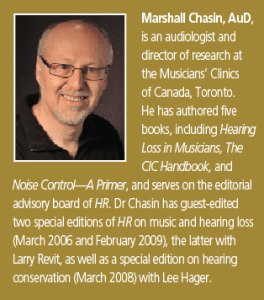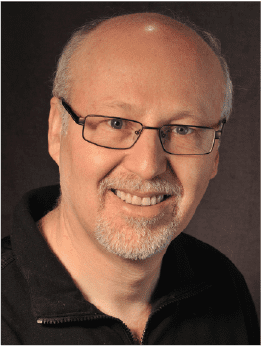Back to Basics | January 2015 Hearing Review
We don’t normally finish with a full day of work, go home to get a change of clothes, and then go back to work thinking “More work today will be fun!” But working with musicians is “fun.”
The clinical knowledge for working with musicians is really everything that we learned in our audiology training, but aimed in a slightly different direction. We get to use the really neat formulae that we learned in hearing aid earmold acoustics to measure (and predict) the spectral output of a musical instrument while it is being played.
For example, we can even add in the real-ear transfer function to predict exact sound levels that would be generated at the eardrum, and then subtract off the frequency-by-frequency attenuation of the ear protectors that we will be using. After all, the ear canal is a quarter-wavelength resonator, just like a behind-the-ear (BTE) hearing aid is—the primary wavelength resonance in a BTE is roughly 1000 Hz, and for an ear canal, it is 2700 Hz—the difference between just the length (L) in the formula F = (2k-1)v/4L. What could be more fun than that?
And then we get to use the same formula to predict the spectral pattern of the trumpet or clarinet—both being quarter-wavelength resonators. A middle C note has a fundamental at 262 Hz when played, but also odd numbered resonances (remember the 2k-1 term?) so it should have energy at 3 x 262 Hz, 5 x 262 Hz, 7 x 262 Hz, and so on. And when we actually measure it with a probe-tube microphone system, that is exactly what happens…
Well, at least for the lower frequency region. In the higher frequency region, all sorts of neat stuff starts to happen. The “effective length” of the musical instrument tube becomes a factor. In the case of the trumpet, the flare “causes” the actual length to be a bit shorter than the measured length so the resonances are slightly higher than predicted. And then the trumpet has a flare that accentuates the magnitudes of the higher frequency harmonics.
Sounds like hearing aid earmold acoustics, doesn’t it? A flared tubing, such as a Libby horn, enhances the higher frequency sound transmission. Clearly, Cy Libby, when he designed the Libby horn, knew about the acoustics of musical instruments.
And more fun. The ear canal resonance is at 2700 Hz on average, but the length of the ear canal is only about 30 mm from the lateral meatal opening to the eardrum on the medial side. So, let’s do the math:
F = v/4L = 340,000 mm/sec/(4 x 30 mm) = 340,000/120 = 2800 Hz. This is slightly higher than expected, since we typically measure only 2700 Hz. And also, many ear canals are only about 25 or 26 mm long, not 30 mm. It turns out that the compliance of the eardrum adds several mm of acoustic length into the calculation, which is why it appears to resonate at a slightly lower frequency than what is calculated from just the quarter wavelength resonator formula.
And this brings us to consider the stiffness (or lack of compliance) of the eardrum and middle ear system with ear canal resonances. This, at least, introduces the question of how middle ear stiffness can be a factor in outer ear acoustics. This rears its ugly head whenever we try to test a hearing aid in a hearing aid test box according to ANSI S3.22.
The 2cc coupler that we use to test hearing aids has a volume of 2 cc (amazing how that always works out!). But the measured volume of the ear canal is not 2 cc. But even if it was closer to a measured volume, such as 1.7 cc as used in some ear simulators, we would still be off. And that’s because the equivalent volume of the eardrum and middle ear structures is a factor in the lower frequency region. For higher frequencies, the outer ear does not “see” the middle ear; the eardrum is an opaque wall for higher frequency sounds, and middle ear structures do not contribute to outer ear acoustics.
A “perfect” ear simulator or coupler for hearing aid testing should then have a larger volume for lower frequency sounds (say about 1.7 cc) and a smaller volume of around 0.7 cc (because it doesn’t see the middle ear contributions) for the higher frequency region. This is a corollary of Boyle’s Law.

However, on a more serious note, it is interesting to look at the work style and lifestyle of those of us who are still truly enjoying what we do after many years. I get to play with musicians, but others may want to play with other aspects of the field of which there are many fun opportunities.
Without sounding too paternal, I suggest that any young audiologist try out some other aspect of the field that they may not have had any experience in…yet. Our audiology training prepares us for so many things beyond the typical things that we do inside a sound-treated booth. I would encourage everyone to step outside of the booth and see what happens. I suspect that you may find that it’s “fun.”
Citation for this article: Chasin M. Working ”Outside the Booth“ Is Fun. Hearing Review. 2015;21(1):12.





